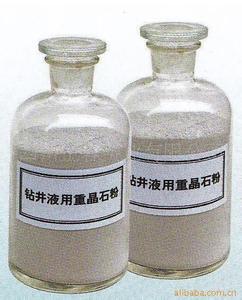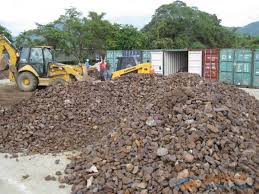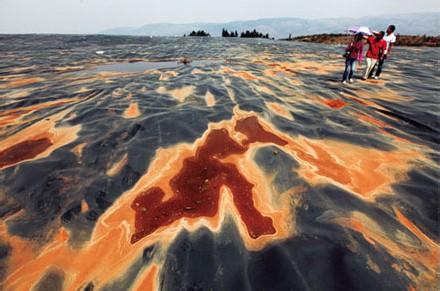Barite Market Development Prospects
Prospects
The main users of barite is petroleum and chemical industries.To the countries which petroleum industry is relatively developed, more than 50% barite production for oil and geological drilling,According to statistics, every drilling rig will consume one ton 30 meters barite powder,so bring greater consumption. In the chemical industry, production of various barium salt and barite have a fixed relationship between the consumption of raw materials and the barite consumption is also great.
 Currently, the world production of barite upward trend will continue, but the growth rate of most of the world’s oil and gas industry depends on the project scale of drilling. According to the data , in 1996 the world barite production was 4.415 million tons , compared with an increase of 1.35% in 1995 . At present, China has become the world’s largest producer of barite , the annual output is 1.5 million tons , accounting for 34% of world production.There are other major producing countries, Mexico , the former Soviet Union, the United States, India, Turkey and Morocco.
Currently, the world production of barite upward trend will continue, but the growth rate of most of the world’s oil and gas industry depends on the project scale of drilling. According to the data , in 1996 the world barite production was 4.415 million tons , compared with an increase of 1.35% in 1995 . At present, China has become the world’s largest producer of barite , the annual output is 1.5 million tons , accounting for 34% of world production.There are other major producing countries, Mexico , the former Soviet Union, the United States, India, Turkey and Morocco.
Development Strategy
Throughout the world barite market , China occupies an important position barite products.With annual export volume of 100 million tons, the total world exports around 60%. Should take full advantage of the current international market demand barite increased prices favorable opportunity to adjust the export product structure and expand the proportion of exports powdered products.To export less and earning more than the amount of direction.
World barite reserves of about 910 million tons , the world’s per capita consumption of 0.18 tons / person. At present, China barite reserves of about 140 million tons , about 0.13 tons per capita / person , according to the forecast , by 2000 , the annual demand for barite is about 750,000 tons , the annual average growth rate of 3.2% Therefore , the availability of resources barite mine life of approximately 70 years. This requires us to strengthen the barite resources seriously because it substitute difficult not rich resources , the proposed export should be limited to protect the barite resources.
Does The Chicken Weight Gain With Barite Poisonous?
 Recently,somewhere in China,the police seized suspected perfusion barytes powder nearly a thousand chickens. Inspection by the local CIQ confirmed it is potting compound mainly barite powder, barium sulfate containing up to 66.63%.People can not help but worry that is it safe eating chicken was infused with barite? According to sources, to chickens perfusion barytes powder, mainly in order to increase the weight, from which illegal profits.
Recently,somewhere in China,the police seized suspected perfusion barytes powder nearly a thousand chickens. Inspection by the local CIQ confirmed it is potting compound mainly barite powder, barium sulfate containing up to 66.63%.People can not help but worry that is it safe eating chicken was infused with barite? According to sources, to chickens perfusion barytes powder, mainly in order to increase the weight, from which illegal profits.
Barite barium sulfate is important minerals for the preparation of barium and barium compounds,containing about 65.7% of barium sulfate and 34.3% of the sulfur  trioxide. In the early 19th century, people began to paint using barite as filler for oil and gas drilling mud weighting agent. Barium sulfate for the production of white pigments, fillers can be used in the coloring agent of rubber. When people are suspected to have gastrointestinal disease, doctors often recommend that patients do gastrointestinal contrast,patients swallow the toothpaste-like shape of the contrast agent is barium sulfate. Since man can swallow barium sulfate, then the chickens will produce barite powder is poured toxicity do?
trioxide. In the early 19th century, people began to paint using barite as filler for oil and gas drilling mud weighting agent. Barium sulfate for the production of white pigments, fillers can be used in the coloring agent of rubber. When people are suspected to have gastrointestinal disease, doctors often recommend that patients do gastrointestinal contrast,patients swallow the toothpaste-like shape of the contrast agent is barium sulfate. Since man can swallow barium sulfate, then the chickens will produce barite powder is poured toxicity do?
- First, patients using barium sulfate contrast agent has reached the pharmaceutical purity standards and chickens were perfused barite powder or uncut state.
- Secondly, in nature,barite often coexist with barium carbonate mineral called Witherite, it’s chemical properties is different from barite. Barium compounds on human toxicity depends on its water solubility. Witherite is a soluble barium salt.
- Finally, Witherite enters the body, the skeletal muscle, smooth muscle and cardiac cause irritation and stimulant. Myocardial soluble barium salt by the toxic effects of myocardial stress and conductivity changes, severe poisoning can occur heart block, ectopic rhythm and ventricular fibrillation, the patient can die of cardiac arrest.
Law enforcement officers seized “barite chickens” on the highway for a trek from Guizhou to Chongqing.But came without the emergence of an unexpected death, from the “barite chickens” performance point of view,it does not appear barium poisoning. Clinically, the acute toxicity of barium minutes incubation period can be as short in most cases the incidence of 0.5-4 hours.
 Barite powder for each live chickens to hundreds of grams of weight gain, but also ensure that chickens accidental poisoning does not occur, the perpetrators must be done in advance of the pre-study and observation. In view of this, the fraud is even worse. Nature of the material is also a lot of high specific gravity, for money wanton act, of course, the victims are innocent consumers.
Barite powder for each live chickens to hundreds of grams of weight gain, but also ensure that chickens accidental poisoning does not occur, the perpetrators must be done in advance of the pre-study and observation. In view of this, the fraud is even worse. Nature of the material is also a lot of high specific gravity, for money wanton act, of course, the victims are innocent consumers.
Centrex gets the rights to NSW project
PERTH (miningweekly.com) – Metals developer Centrex Metals has been granted the mining rights to the Gundaroo gold/base metals project, in New South Wales.
The company applied for the Gundaroo tenement with a view to expand its base metals exploration portfolio within the East Lachlan Ford belt, and said on Thursday that exploration would start later this year.
The Gundaroo project is located some 10 km west of Centrex’s existing Gouldburn base metals joint venture (JV) with China’s Shandong 5th Geo-Mineral Prospecting Institute.
A desktop review has concluded that the Gundaroo licence area has been underexplored, and was prospective for both hydrothermal gold and sulphide-hosted base
metals, Centrex said.
In addition to the Gundaroo approval, the company was also granted a new 250 km2 type two industrial minerals licence overlaying the current mineral tenements of the current Gouldburn JV, where both barite and lateritic bauxite occurrences have been identified.
Centrex told shareholders that it would explore for these minerals, in conjunction with the upcoming A$2-million base metals exploration programme being funded by JV partner Shandong, to earn a 35% interest in the JV.
The completion of the JV was subject to both Chinese and Australian government approvals, which were expected later this year.
Antimony
History of antimony
Antimony minerals, particularly stibnite, have been known and used since ancient times. Because it is so soft, stibnite was used in ancient times as  black eye makeup. The Roman historian, Pliny, wrote about its use as a medicine. Artists used finely-ground stibnite in the Middle Ages as a black pigment. Ancient “scientists” were interested in antimony because of their belief that it may be useful in the process of changing common metals into gold. This field was known as alchemy.
black eye makeup. The Roman historian, Pliny, wrote about its use as a medicine. Artists used finely-ground stibnite in the Middle Ages as a black pigment. Ancient “scientists” were interested in antimony because of their belief that it may be useful in the process of changing common metals into gold. This field was known as alchemy.
What is antimony
Antimony is a native element,antimony metal is extracted from stibnite and other minerals. Antimony is used as a hardening alloy for lead, especially storage batteries and cable sheaths, also used in bearing metal, type metal, solder, collapsible tubes and foil, sheet and pipes, and semiconductor technology.
Application of antimony
 The most important use of antimony is in chemicals used to impregnate plastics, textiles, rubber, and other materials as a flame retardant – that is, a form of fireproofing.Over half the annual U.S. antimony consumption is for the manufacture of flame retardants.
The most important use of antimony is in chemicals used to impregnate plastics, textiles, rubber, and other materials as a flame retardant – that is, a form of fireproofing.Over half the annual U.S. antimony consumption is for the manufacture of flame retardants.
Antimony is mixed with other metals and turned to alloyed,such as lead, to make the lead harder and stronger for use in lead-acid batteries.On the other hand,some alloys such an an alloy of antimony,tin,copper,and sometimes lead are useful as machine bearings because they are soft and slippery.Antimony is also alloyed with tin to make pewter items such as plates, pitchers and cups, used mostly for decoration.
Antimony is also used for pigments in plastics, paints, rubber and for a wide variety of minor uses, including medicines, fireworks, and others. Antimony oxide is a brilliant yellow color, accounting for much of the pigment use.Stibnite is used for metal antifriction alloys, metal type, shot, batteries, and in the manufacture of fireworks. Antimony salts are used in the rubber and textile industries, in medicine, and glassmaking.
Sources of antimony
Most of the antimony mined each year comes from China, which supplies over three-quarters of the world total. The remainder is from Russia, South Africa, Tajikistan, Bolivia, and  a few other countries. Some antimony is produced as a by-product of smelting ores of other metals, mainly gold, copper and silver, in countries such as the United States, Canada, and Australia.
a few other countries. Some antimony is produced as a by-product of smelting ores of other metals, mainly gold, copper and silver, in countries such as the United States, Canada, and Australia.
Arsenic
Brief look of Arsenic
Arsenic is a toxic and known to metals, and there are many allotropes. Arsenic widely found in nature, there are hundreds of species of arsenic minerals have been found.Because  of weak bonding between the layers, gray arsenic is brittle and has a relatively low Mohs hardness of 3.5.
of weak bonding between the layers, gray arsenic is brittle and has a relatively low Mohs hardness of 3.5.
Arsenic metal very rarely occurs in its pure form in nature. The most common arsenic mineral is arsenopyrite, a compound of iron, arsenic, and sulfur. Several other, less-common minerals contain arsenic, including orpiment, realgar, and enargite, which are arsenic sulfides.
Application of Arsenic
 Arsenic and its compounds are used in pesticides, herbicides, pesticides and many kinds of alloys.Formerly the most important use of arsenic compounds, was as an insecticide sprayed in fields and orchards.
Arsenic and its compounds are used in pesticides, herbicides, pesticides and many kinds of alloys.Formerly the most important use of arsenic compounds, was as an insecticide sprayed in fields and orchards.
Only about 5% of arsenic consumption is of the metallic element. Most of this is used to alloy (mix) arsenic with lead, copper, or other metals for specific uses.As a metalloid, arsenic is a semiconductor, like silicon.This means it conducts some electricity like a metal,but not all the electricity a true conductor like copper would conduct. Consequently, about 1/10 % of arsenic is consumed in the manufacture of gallium arsenide semiconductors for use in electronics. Some arsenic is also used in glass-making.
Source of Arsenic
Significant quantities of arsenic are associated with the copper-gold deposits in Chile, the Philippines, and many other countries. However, many countries produce by-product 
arsenic from smelting of metal ores. China is by far the largest producer, with Chile, Mexico, and Peru also important, and lesser production from about a dozen other countries
with metal smelters.






Recent comments